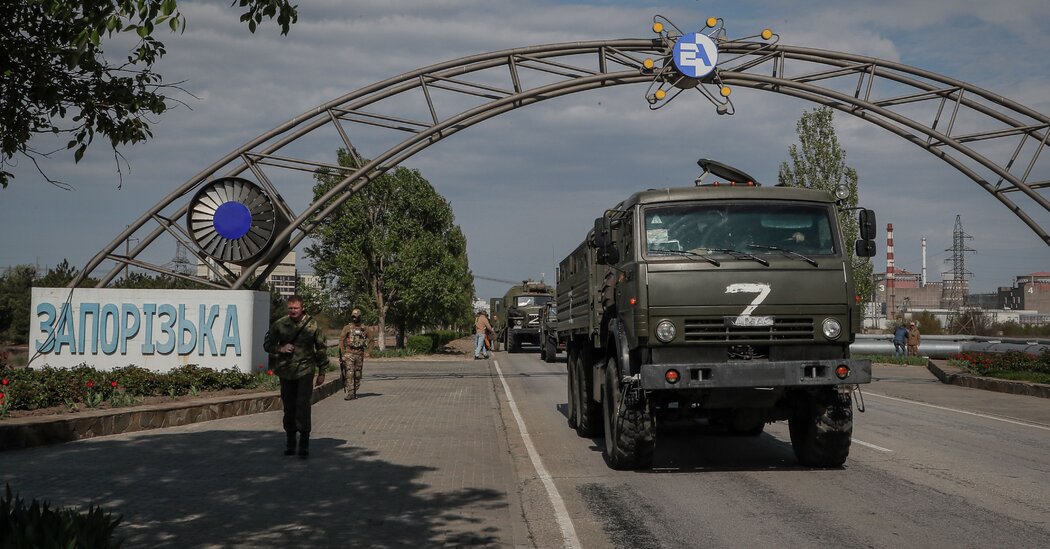As Russia reinforces defensive positions in occupied regions across southern Ukraine and takes measures to exert political and cultural dominion over the local population, a high-ranking Russian official visited the region this week and outlined plans to take control of vital infrastructure, including Europe’s largest nuclear power plant.
“I believe the region’s future is to work in our friendly Russian family,” said Marat Khusnullin, Russia’s deputy prime minister for infrastructure. “I came here to proe maximum opportunities for integration.”
While it was not clear if Mr. Khusnullin’s comments reflected official Kremlin policy — President Vladimir V. Putin has not said what he aims to do with lands captured outside Ukraine’s eastern Donbas region — they appeared to fit into a pattern of Russian efforts to “Russify” occupied territories.
Moscow has already moved to introduce Russian currency, install proxy local politicians, revamp school curriculums, reroute internet servers through Russia and cut the population off from Ukrainian broadcasts. Ukrainian officials have accused Russia of forcibly deporting thousands of people to Russia, and residents in some occupied territories have described increasingly repressive efforts to enforce Russian rule.
The Kremlin has sought to portray its actions as in line with popular will. Dmitri S. Peskov, the Kremlin’s spokesman, played down the significance of Mr. Khusnullin’s statements, saying only locals could decide the fate of these regions. But a U.S. official warned this month that the Kremlin could seek to annex the Donbas region and Kherson, the largely Russia-controlled region that Mr. Khusnullin visited, by staging “sham” elections.
Some officials in Russia appear to be pushing in that direction. On Thursday, a group of Russian lawmakers submitted a bill that would allow Mr. Putin to establish “temporary administrations on territories where Russia’s army conducts military operations.”
Analysts at the Institute for the Study of War, a Washington think tank, said “the wildly varying reports” of possible dates for a referendum in Kherson, along with official denials of plans for annexation, “suggest considerable confusion within the Russian leadership at various levels about Russia’s prospects for securing the area and, possibly, the best way forward.”
The latest moves throw into stark relief the ambiguity of Russia’s war aims and the Kremlin’s chaotic messaging about the goals of the invasion — even to its own people. When Mr. Putin announced the invasion in his early-morning address on Feb. 24, he said Russia did not plan to “occupy Ukrainian territory” and that his aim was to aid the people of the Donbas — the eastern Ukrainian region that Russia now recognizes as independent of Ukraine.
The Kherson region, however, is not part of the Donbas — its eastern edge lies about 100 miles to the southwest. And this week’s developments show that Russia may be laying the groundwork for a long-term occupation or annexation of areas beyond the Donbas.
President Volodymyr Zelensky has vowed that Ukraine would take back Kherson and other occupied lands, but so far Ukrainian forces have struggled to mount a major counteroffensive in the region.
The area Russia controls in southern Ukraine — a vast sweep of land that is larger than the Baltic state of Estonia — was largely taken in the first weeks of the war.
Russia has had control over the Zaporizhzhia Nuclear Power Plant in Enerhodar since early March. When fully operational, the six reactors at the plant can produce around 6,000 megawatts of power, enough energy for some four million homes. At a news conference in the occupied city of Melitopol, Mr. Khusnullin said Ukraine would have to pay for electricity supplied by the plant.
“If not,” he said, the plant “would be working for Russia.”
Ukraine’s national energy proer, NPC Ukrenergo, called the threat nuclear blackmail, and said Russia was seeking to gain leverage over Ukraine and Europe.
Russia-Ukraine War: Key DevelopmentsCard 1 of 4
Russia’s punishment of Finland. Russia cut off its natural gas supplies to Finland on May 21, according to Finland’s state energy proer. Russia said that it was suspending the supply because Finland had failed to comply with its demand to make payments in rubles. Finland has also submitted an application to join NATO, angering Russia.
In the port city of Kherson, near the border with Crimea, Mr. Khusnullin inspected the local port, a cargo railway station and a factory. Russia had allocated funds to restore the city’s roads and pledged that “we will live and work together.”
But around the same time as he spoke, Ukrainian officials said a convoy of civilian cars trying to flee the region came under fire from Russian soldiers.
Mr. Khusnullin also referred to Kherson’s status as Ukraine’s breadbasket, saying: “We will now eat tomatoes and tomato paste more often in Russia thanks to the work of Kherson’s agricultural producers.”
Ukraine this week accused Russia of robbing Kherson of 400,000 tons of grain, sending it to Russia and creating conditions that “may lead to famine in the occupied territories.” And a Russian naval blockade was keeping Ukraine from exporting millions more tons, fueling a global food crisis.



